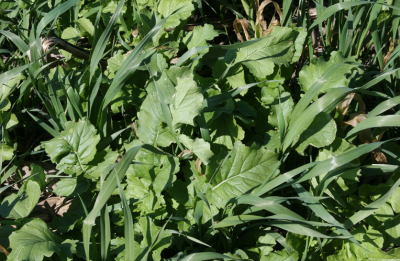 Rye Turnip Cover Crop (GROWMARK, Inc.)
Rye Turnip Cover Crop (GROWMARK, Inc.)
- Cover crops are an important management tool in reducing nutrient losses from agricultural fields.
- Species selection should be driven by the specific goal/(s) of the farmer.
- Single species cover crops may be easiest to get started with, however, the spectrum of benefits may be narrower than a multiple-species mixture.
- Mixed cover crop species generally provide a more diverse array of benefits to meet goals but may be more complex to manage.
- Successful integration of cover crops requires intensive and timely management.
Cover crops are expected to be a prominent management tool in reducing nutrient losses from agricultural fields, but they can also provide many additional benefits depending upon the species or mix selected. When determining which cover crop(s) to plant, a farmer should have some goals in mind. These may include:
- Reducing soil erosion and nutrient loss
- Scavenging and temporarily holding excess soluble nutrients
- Generating biomass to improve organic matter and soil health
- Providing nitrogen for the following cash crop
- Suppression of weeds or pathogens
- Diversifying the crop rotation and breaking disease cycles
Cover crops require intensive and timely management for successful integration into your farming system, just like the cash crop. Management factors include species and variety selection, seeding rate, seeding method, timing of establishment, timing and method of termination, residue management, and pest issues. Failure to actively manage these factors can lead to reduced yields in the subsequent cash crop and significant additional costs.
In this article, we will review the benefits and management considerations of a few select cover crop species in use across the Midwest.
Grasses
Benefits: Grasses are generally effective at protecting against soil erosion, scavenging nutrients, and improving soil quality, with the penetration of their fibrous roots into the soil. Some grasses may help suppress weed growth by preventing sunlight from reaching the soil surface and reducing weed seed germination. Grasses are excellent cover crops to help aid in establishment of legumes or brassicas. Grasses contribute large amounts of biomass to help protect the soil and conserve moisture in no-till systems. Some winter cereals, like cereal rye, tolerate late seeding and fit well into corn-soybean rotations prior to soybeans. Winter cereals will overwinter to generate more biomass in the spring. Spring cereals, like oats, planted in the fall will self-terminate in the winter, avoiding herbicide burndown costs and releasing nutrients more quickly the following year. Grasses can provide excellent grazing forage for livestock producers, however, be cognizant of herbicide plant-back intervals to avoid any residues in the forage.
Management Challenges: Some grasses, particularly annual ryegrass, can become problematic to control in the springtime. Some annual ryegrass populations in the Southern US have developed resistance to glyphosate. Cereals and grasses effectively immobilize nutrients, but with a high carbon-nitrogen ratio, subsequent nutrient release may be delayed, especially nitrogen. Small grain cover crops may harbor insect pests like cutworms, armyworms and slugs. Timely termination 2-3 weeks before planting can be a challenge in a wet, cool spring. Dead grass residues tend to keep soils cooler and wetter, which can delay planting. Planting delays have recently led to experimentation with ‘green-planting’ techniques, where the cash crop is planted into green standing cover that is terminated a few days after planting. With this being a relatively new concept, little-to-no published data is available from university research on benefits or precautions on this practice.
Legumes
Benefits: Legumes are noted for having roots that penetrate deep into the soil, if established early enough and allowed to grow long enough they can help fracture compacted soils. Most legumes will contribute nitrogen for the next cash crop. With a lower carbon-nitrogen ratio, the legume residue usually breaks down more quickly and releases nutrients at more optimal timing than grasses.
Management Challenges: With the exception of crimson clover, many legumes are slow to establish in the fall. Clovers have traditionally been seeded into or planted after harvest of winter wheat. In corn-soybean rotations, legumes must be inter-seeded into the standing cash crop in order to promote adequate fall growth. Some legumes, like hairy vetch, can be competitive but in difficult to terminate the spring.
Brassicas
Benefits: The common brassicas used as cover crops in the Midwest include radishes (oilseed radishes or tillage radishes), turnips, rapeseed, and canola. Tillage radishes establish rapidly in the fall and produce a large taproot that penetrates through soil hardpans better than legumes. Radishes are good companions with grass species, help scavenge excess nutrients, and readily winter kill. When the radishes die, they leave open channels into the soil to improve infiltration and cash crop root penetration. Radishes readily release sequestered nutrients. Some research has shown that the by-products of brassica decomposition may suppress nematode populations. Some brassicas, like turnips, are well-suited for winter grazing forage.
Management Challenges: Radishes may emit strong, pungent odors when decomposing, which neighbors may find offensive. Some soil experts are concerned that the channels, left in the soil where radishes are grown, may inadvertently serve as direct conduits for nutrients to leave the field via macro-pore water flow.
While cover crops provide many benefits, they also share some challenges that require a plan in place prior to planting. Be mindful the benefits most always outweigh the challenges! Contact your local Crop Specialists for information and plans to establish cover crops on your farm.